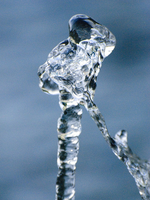 |
| 'Water walker' by Navdeep Raj under a CC license |
Water, maybe?
It doesn't take much thought to reply to that, does it?
A couple of days ago (on 18/11, to be precise), The Telegraph featured an article titled "EU bans claim that water can prevent dehydration". The article comments negatively on legislation that follows an EFSA opinion, which rejects a health claim on the potential of water consumption against dehydration. The EFSA opinion is not a very new story but it seems to have resurfaced. The said article was also in slashdot yesterday, so I assume that it has received plenty of attention world-wide by now.
Interesting article, with negative bias, regardless of the fact that both quotes and facts are provided. The article suggests that EFSA's opinion and the subsequent legislative act are really against common knowledge and are, thus, wrong. Apart from that, according to the article, the whole process has been rather expensive (for the taxpayer). Only at the very end of the text does a supportive (for EFSA) opinion appears, with no further comments given.
Well, let's see where this case stands. The claim that was submitted to EFSA for their opinion was "regular consumption of significant amounts of water can reduce the risk of development of dehydration and of concomitant decrease of performance". It was submitted by two German professors (some internet sources say they are consultants for the bottled water industry) under Art. 14 of Regulation EC/1924/2006, which covers claims for the reduction of disease risk.
EFSA said (and repeated) that the submitted claim did not meet the requirements of Art. 14 for the reduction of disease risk. The European Federation of Bottled Water seems to agree. Dehydration is a state of the body and - itself - is not a disease, although it can be a side-effect/ symptom of various diseases. I admit, however, that EFSA's opinion has been written in a rather complicated way, where they seem to somehow accept dehydration as a disease before concluding that the requirements of the Regulation are not met!!! Strange....
To make things interesting, the responsible EFSA's panel had given favourable opinions on the role of water for "maintenance of normal thermoregulation" and for it being a "basic requirement of all living things" - both claims falling under Art. 13 of Regulation EC/1924/2006, which includes claims on "the role of a nutrient or other substance in growth, development and the functions of the body". In order words, it seems plausible that the claim was filed under the wrong classification. If that was really the case, EFSA should not be the one to blame for that.
It is clear that all nutrition and health claims submitted for consideration should be rigorously processed. That 's what the law foresees and that 's what is needed in order to protect the consumer and maintain a competitive - but fair - market. Submitting obvious (or stupid) claims doesn't mean that they won't go down the processing pipeline. And although that this comes with a price-tag, there's no safe way to go around that; there is no "obviousness" clause that would allow the EC (or EFSA) to accept or reject a proposed claim.
Going a bit beyond, I really wonder, what is the reason of having a health claim supporting that water can help against dehydration? If it is common knowledge (which it is), why apply for it? In any case, the EU law would prevent such a claim phrased in a way that it would benefit a particular product, since the beneficial function is performed by any drinkable water (yes, including tap water :-)
Was it an effort to prove that the system is broken? If that was it, then point taken. And then immediately, point put aside. Every system that is open to all and is committed to dealing with all has similar weaknesses. I've got nothing against improving a system, if that is needed, but passing the obvious through formal channels so as to see what happens is a questionable practice...




